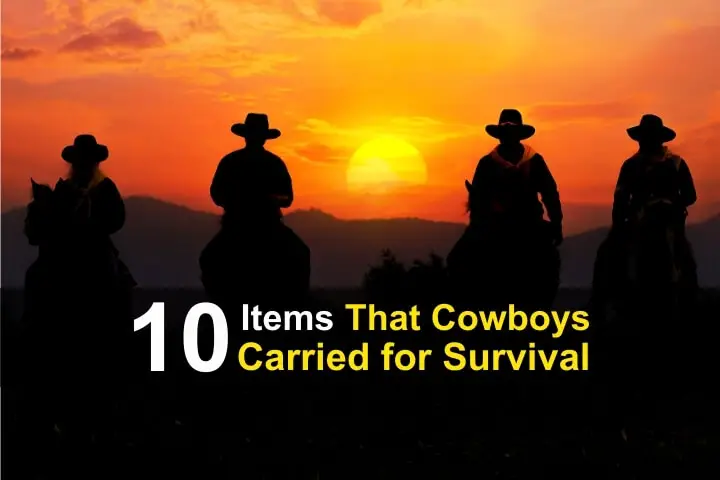Estimated reading time: 5 minutes

Cowboys had it good when they were in camp, with easy access to food, gear, and supplies from the chuck wagon. But once they headed out on the trail, life got a lot tougher. Out there, it was just them, their horse, and whatever they could carry. Every item had to earn its place, and survival depended on having the right gear.
A lot of the survival items they carried might seem old-fashioned today, but if there’s one thing we’ve learned from history, it’s that the old ways endure for a reason. Simplicity, durability, and multipurpose tools were the backbone of cowboy survival, and they still hold up in the modern world.
Want to save this post for later? Click Here to Pin It On Pinterest!
Recently, I came across a great video on this topic by Sensible Prepper, where he covers ten essential items cowboys carried on the trail. Below is the video along with a breakdown of those items.
1. Cowboy Hat
- Then: Though today we picture the classic Stetson, the iconic wide-brimmed felt hat only became popular in the late 1800s. Before that, bowler hats were more common because they’re practical and wind-resistant.
- Why it mattered: It shielded eyes, face, and neck from the harsh sun, raindrops, and winter winds.
- Modern takeaway: A durable, functional wide-brim hat is a timeless piece of kit. Consider one with “stampede strings” (chin straps) to keep it secure during high winds.
2. Bandana
- Then: A simple cotton square multi-functioned as sun protection, a dust mask, a sweat-wiper, and even an improvised scrub cloth. Originating from soldiers discarding leather stocks after the Mexican War, it became a staple neckwear.
- Modern takeaway: A bandana remains one of the most versatile, low-cost tools in survival kits. Use it as a filter, tourniquet, or sling.
3. Cowboy Boots
- Then: Built for dusty trails, tough brush, and long days in the saddle, cowboy boots offered ankle support, heel grips, and protection from thorns and debris.
- Modern takeaway: Rugged, well-fitted boots still outperform sneakers in longevity and protection, especially critical if your terrain is rough or thorny.
4. Canteen
- Then: Typically two-quart vessels made of leather, metal, or wood, often wrapped in cloth so that evaporative cooling kept the water drinkable longer.
- Modern takeaway: Staying hydrated is non-negotiable. Insulated or wrapped water containers still help keep liquids cool in summer heat, and robust materials prevent damage from drops or compression.
5. Cookset
- Then: With no chuck wagon in sight, cowboys packed a billy can or a coffee pot, tin plate, cup, and maybe cutlery. Coffee was a high-priority morale booster.
- Modern takeaway: Compact nesting cookware remains essential. Embrace lightweight metal sets, but don’t sacrifice a reliable mug or coffee pot if morale counts.
6. Sheath Knife
- Then: A five-to-seven-inch fixed-blade was a must-have. Whether prepping food, cutting rope, or defending oneself, a sturdy knife was a multi-tool long before multi-tools existed.
- Modern takeaway: A high-quality fixed-blade still earns its place in gear loads. Opt for full-tang construction and carry in a secure sheath.
7. Tinder Box
- Then: Flint and steel, char cloth, waxed jute, all sealed in a small metal box made fire-starting reliable and repeatable, even in damp weather.
- Modern takeaway: Carry waterproof matches or a ferro rod; add char cloth or dryer lint with petroleum jelly for quick boots-on-fire-starts in any weather.
8. Strips of Rawhide (Cordage)
- Then: Cowboys used rawhide strips for everything from saddle repair to improvised repairs and gear lashings. Piggin strings (for livestock) and rawhide were practical and multipurpose.
- Modern takeaway: Always carry cordage such as paracord or nylon line. Its range of uses, from shelter building to lashing gear, mirrors rawhide’s trail-tested utility.
9. Bedroll
- Then: A layered bundle of waxed canvas tarp wrapped around wool blankets served as sleeping bag, groundsheet, pillow, and storage trunk. Packable, waterproof, and rugged.
- Modern takeaway: The modern sleeping bag is lighter, but sometimes too specialized. Consider layering a durable tarp over a thick blanket for versatility and warmth while staying minimal.
10. Rifle and Pistol
- Then: A reliable lever-action rifle (like a Winchester) was the workhorse—for hunting and protection. A six‑shooter pistol, while common in media, was more of a luxury carried by gunfighters or townfolk, not the average trail cowboy.
- Modern takeaway: If hunting is in your survival plan, choose dependable, maintainable firearms. Otherwise, carry gear proportionate to need, not myth.
And Oh Yeah
There’s one more thing. Actually two. But you’ll have to watch the video to learn about them. You’ll want to watch it anyway because he goes into more detail about these 10 survival items.
Like this post? Don’t Forget to Pin It On Pinterest!
You May Also Like:
Read full article here




